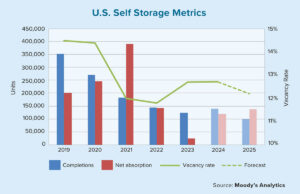It feels as though everyone in commercial real estate is pinning their hopes for expansion this year on the Federal Reserve cutting interest rates. Those hopes may be fleeting and, even if rates are cut, the commercial market may still face challenges.
The prevailing sentiment is that the Federal Open Market Committee will cut rates several times throughout 2024. At least that is what the bond and equity markets are predicting as well as those economists in the “soft landing” camp. Other Fed watchers, however, continue to see a recession looming.
“A prevalent attitude is that this Fed will not cut rates too quickly for fear inflation could flare up again, especially after they were so slow to react initially, deeming inflation ‘transitory.”
There are essentially three camps with varying outlooks on the direction of the U.S. economy. There are those in the so-called “soft landing” camp who believe the Fed can successfully guide the economy down to its 2% inflation target without severely slowing growth or hurting the job market.
Then there are those in the “hard landing” camp who believe that a recession is imminent. And finally, there are those in the “no landing” camp who believe the economy will continue to grow with virtually no slowdown at all.
Different camps
A soft landing is a rare accomplishment. The last time this happened was in 1995. In that case, the economy was emerging from a prolonged recession and bond rates began to rise, raising concerns for the Fed.
The inflation rate was at 3% and unemployment was stable, but the real funds rate (the nominal rate minus inflation) was 0%. The Fed was worried inflationary pressures were building so they raised the target rate by three percentage points over the course of a year and the U.S. avoided a recession.
A prevalent attitude is that this Fed will not cut rates too quickly for fear inflation could flare up again, especially after they were so slow to react initially in 2021, deeming inflation “transitory.” So, it makes sense that they would hold rates relatively steady until well into the second half of 2024.
Recession worries
While there are some Fed watchers who say we could see a rate cut this month, there is little impetus for the Fed to reduce rates if the economy is still growing at more than a 2% annual clip and unemployment remains below 4%. So, it buys the Fed time to wait for future months of data to ensure inflation remains at or below their target before having to pull the trigger.
This strategy, however, could eventually hurt the economy and trigger a hard landing, which would include a slowdown in job growth and economic expansion. In addition, heightened geopolitical risks, including in the Middle East, could also derail the progress the Fed has seen in inflation.
Not to mention 2024 is an election year and appears poised to be as tumultuous as any in recent history. A point to consider is that slowing growth can spur rate cuts, which can result in a hard-landing recession.
Precarious position
Rate cuts are not necessarily a panacea for the commercial real estate market, either. If they come on the heels of inflation cooling to the 2% target without a dramatic impact to growth or unemployment, then the commercial market could see tremendous upside. The Fed can also be forced to cut rates as a result of a crisis in the economy.
Some stock market watchers are expecting as many as six rate cuts this year, which seems unlikely. The problem with this overly optimistic prediction is that if the Fed does not meet those expectations, you can expect a chain reaction in which there is a dramatic stock market selloff. That would in turn cause bond yields to rise which will then result in higher rates for commercial real estate.
Hence, the Fed is in a precarious position. One thing to expect from this Fed is that they are committed to not acting too quickly to lower rates, especially after their initial mischaracterizing inflation as transitory. This Fed will not claim that their mission is accomplished until it is confirmed that target inflation has been achieved and for a comfortable period in order to avoid cutting rates too soon and seeing inflation increase again.
Rate problems
While it is true that lower rates will help property owners service their debt more easily, if those lower rates come because of a recession every part of the economy will be adversely impacted. A weaker job market could add to the woes of the commercial real estate market.
Lower interest rates usually reflect a weaker economy, and a weaker economy can lead to lower property values. For example, think about the impact of rents on the consumer price index (CPI), a government measure of the inflation in prices paid by consumers for a variety of goods and services.
Rents can fall as a result of a recession. This is good news for the Fed and the economy, but negative news for landlords of multifamily properties. One of the key components of CPI is rent, but it is a lagging indicator. Rents are a category the Fed watches very closely in its fight to bring down inflation.
Currently, rents are holding relatively firm in many geographic areas mainly because home prices and interest rates remain high, keeping rental vacancy rates down. This can change with the addition of new supply, but multifamily construction is slowing due to higher interest rates and increased production costs. Still, many consumers are deciding to remain in a rental property given the prohibitive costs of purchasing a primary residence.
Double-edged sword
This also could change once interest rates fall because inflation is in check. In the multifamily sector, lower inflation may trigger lower rents, which equals lower net operating income for landlords. That in turn means lower values.
For property owners seeking to refinance, lower rates can certainly help deals pencil out more favorably for financing but that can be offset by lower revenue. In short, this is a double-edged sword.
The same can be said for office properties. A weaker economy results in fewer jobs and decreased demand for an already struggling office sector. This can translate to other segments of the market, such as hospitality.
A weaker economy also means fewer people are traveling or taking vacations, so demand for hotel rooms decreases. Such a turn will reduce the revenue per available room (RevPAR), a popular performance metric for the hospitality industry.
For small mixed-use properties, recessions pose financial challenges for small businesses so landlords may find it hard to retain good tenants or to find new ones. For industrial properties, reduced consumer demand slows the growth of the industrial sector and could cause an oversupply issue. The retail property sector would also experience challenges. If consumers cut back on buying goods, revenue to retail properties would be reduced and businesses would suffer.
So, rates may not always be the solution to a slowing commercial real estate market. In a perfect “goldilocks” scenario, inflation cools to the Fed’s target of 2%, unemployment remains historically low and growth remains strong. In that case, the outlook would be that multiple rate cuts would have the expected positive impact on the market.
If, however, growth slows too fast, unemployment rises and inflation remains sticky, then the real estate market would experience a potentially severe decrease in values. If the Fed decides to be more cautious and hold rates higher for longer, the result would also be more pain for commercial real estate.
Positive performers
Even in such a murky market environment, there are things that commercial mortgage brokers can do to survive, and even thrive, should the Fed hold rates steady. The main move would be to focus on sectors that continue to perform well, including the industrial sector. The demand for warehouses, self-storage projects and medical practices may have cooled, but they are still strong commodities.
Another area to focus on is Small Business Administration loans, particularly 504 loans, which can be used for major business purchases such as real estate, machinery and equipment. The SBA’s 7a loan is another program that allows for the acquisition of real estate, refinancing and more. Brokers also will want to focus their energies in geographic areas showing strong population and economic growth.
Because rates could remain elevated for some time, brokers working with clients who need to refinance should present current deals as essentially bridge loans with an eye toward refinancing in the future when there is a more favorable interest rate environment.
This strategy sets the table for future deals and helps borrowers absorb current market rates more readily because they won’t view their current loan as permanent. Perhaps looking toward interest-only loan programs and limited or no-prepayment transactions are other good ways to structure those refinancing deals as well.
● ● ●
All indications are that 2024 will be a challenging year. Brokers will need to be nimble to ensure they have options for transactions and not focus all of their energy on any one segment of the market.
Lenders will remain cautious as the commercial market sees more loans coming to term. They will wait to assess the ramifications on property values and loan performance. Navigating clients through these trying times will go a long way toward establishing lasting relationships for future business. ●
Author
-

Rob Diodato is the president of York Commercial Finance, a commercial mortgage advisory company with offices in Dallas and New York. Diodato arranges financing for commercial real estate transactions nationwide for all property types. Diodato has more than 26 years of experience in the commercial and residential mortgage industries.
View all posts






